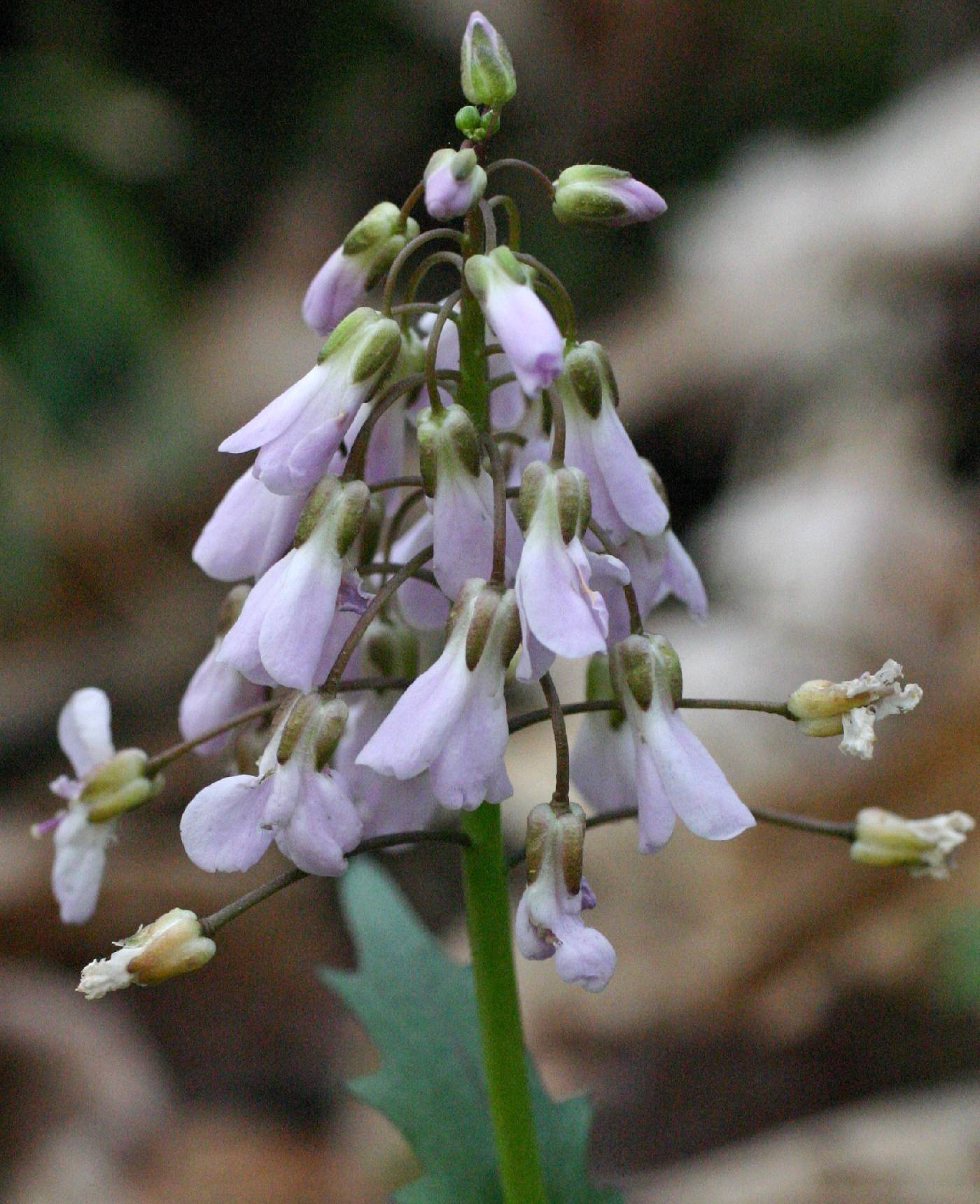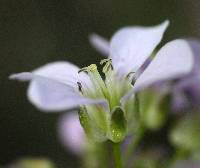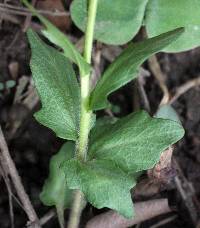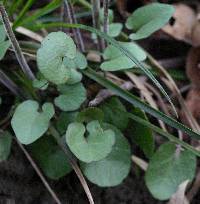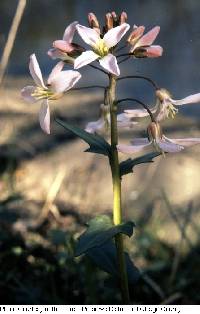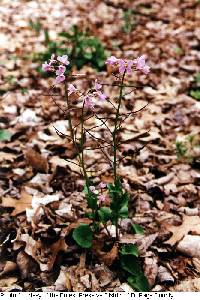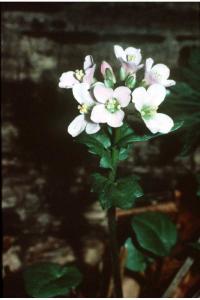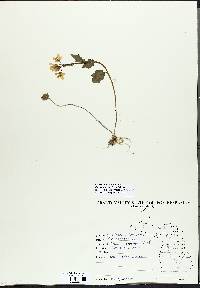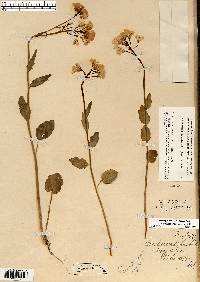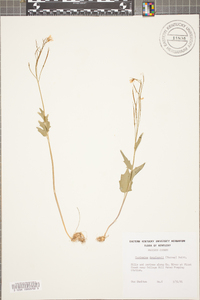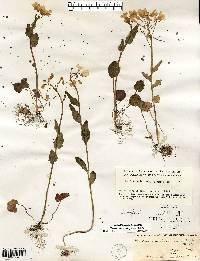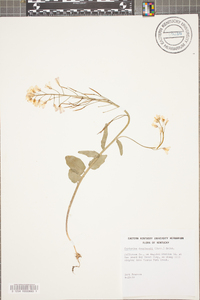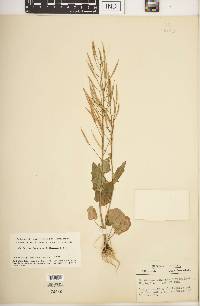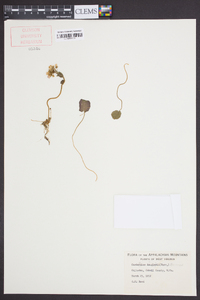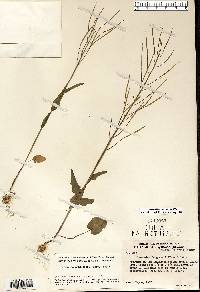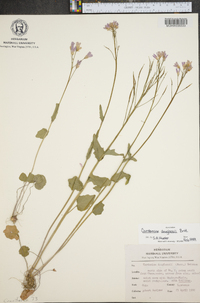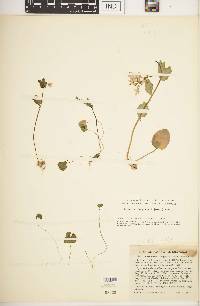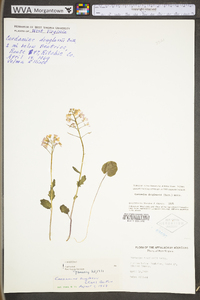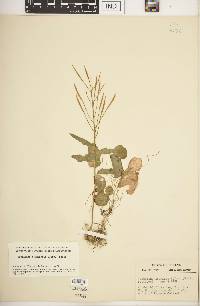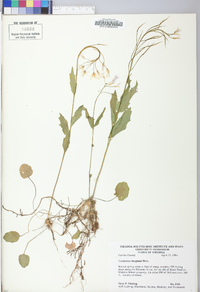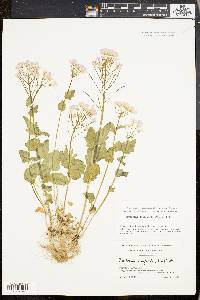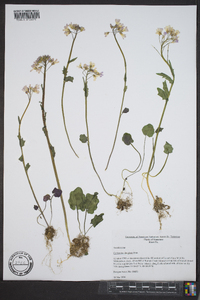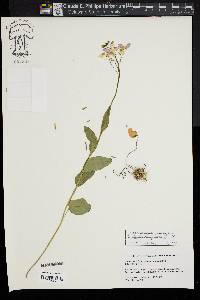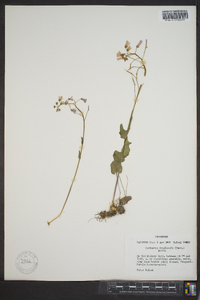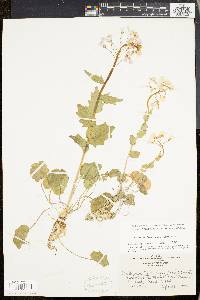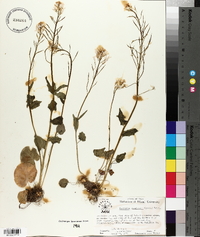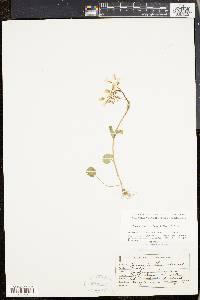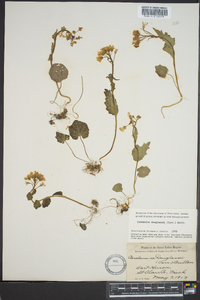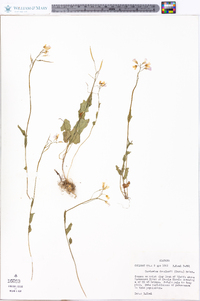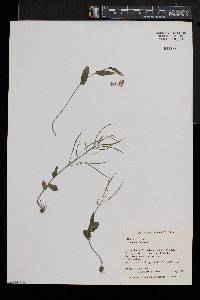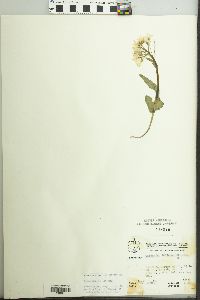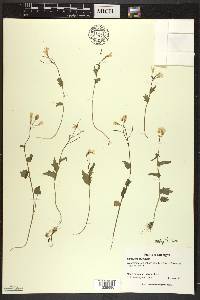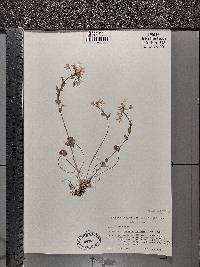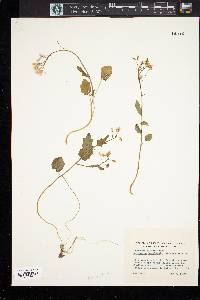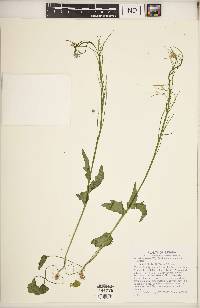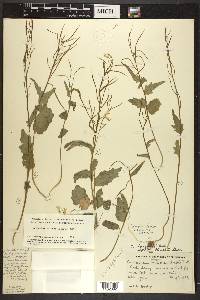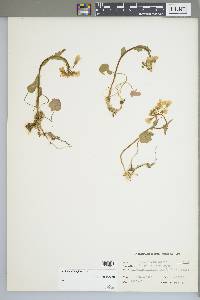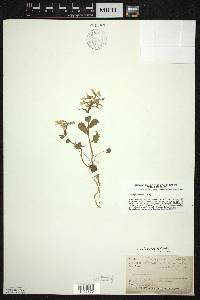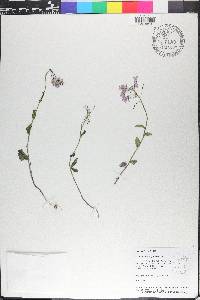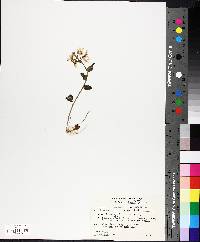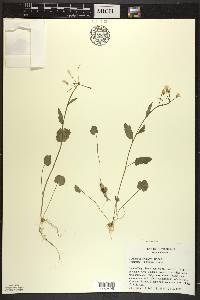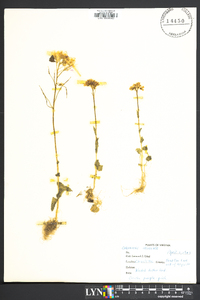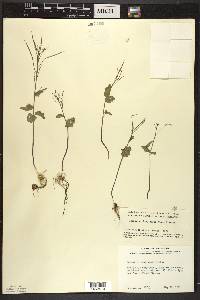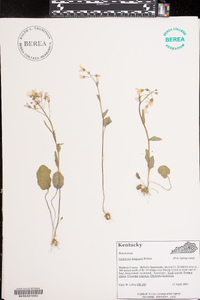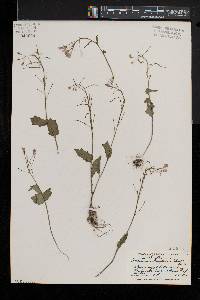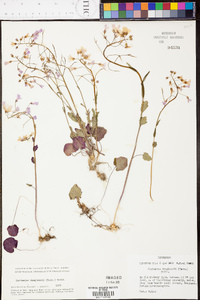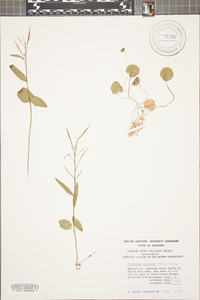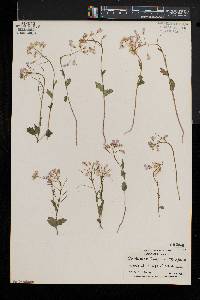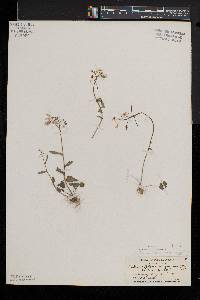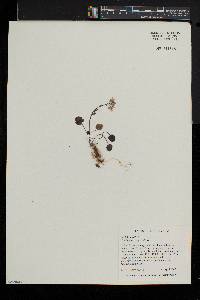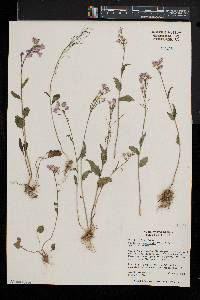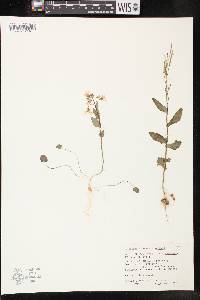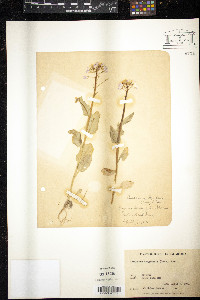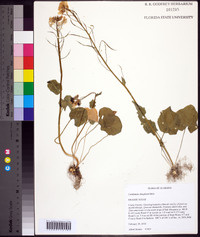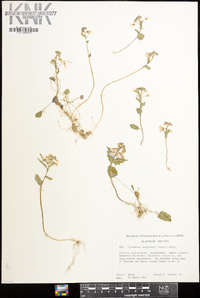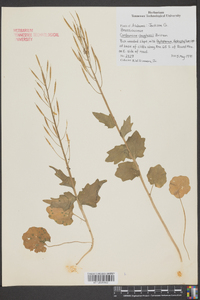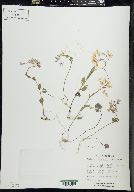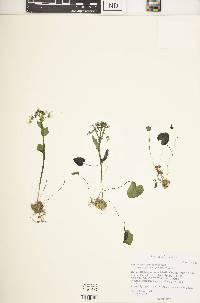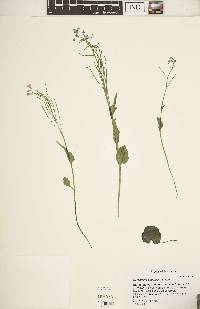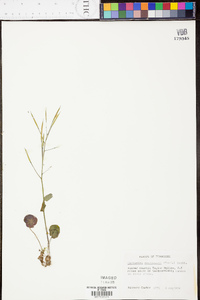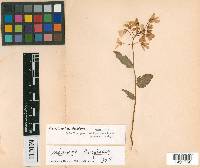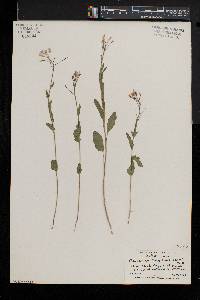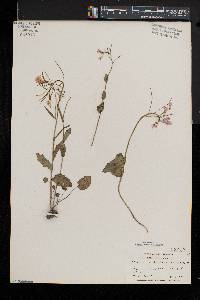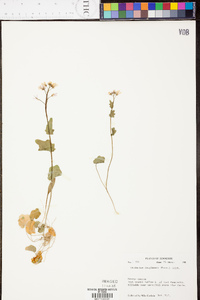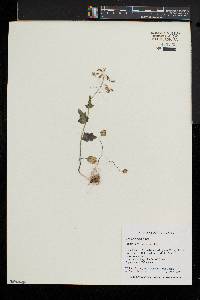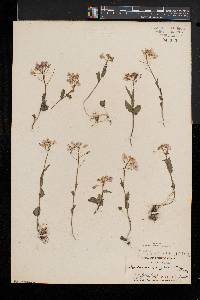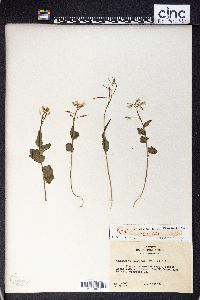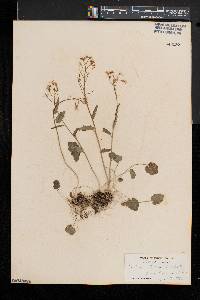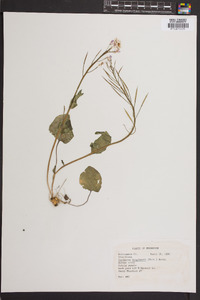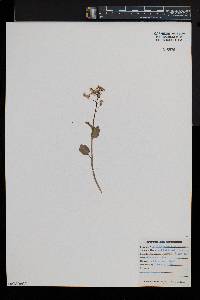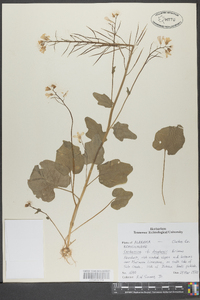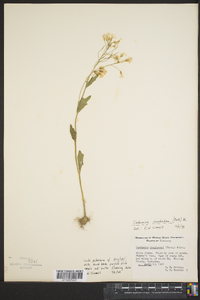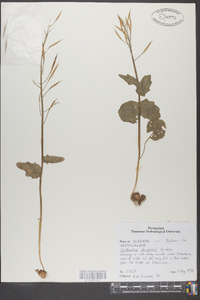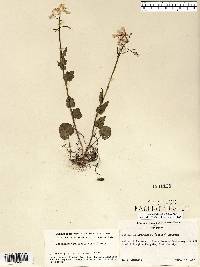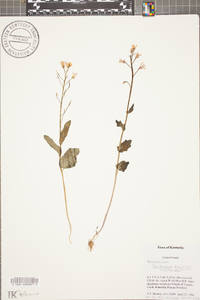
|
|
|
|
Family: Brassicaceae
Limestone Bittercress
[Cardamine douglasii Britton] |
Perennials; hirsute throughout or glabrous proximally. Rhizomes (tuberous at stem base), subglobose, (lobed or not), (3-)4-10 mm diam., (fleshy). Stems erect, unbranched, (0.7-)1-2.5(-3) dm, sparsely to densely hirsute, or glabrous basally, (trichomes (0.2-)0.3-0.6(-0.8) mm). Rhizomal leaves simple, (3-)5-15(-18) cm; petiole (2-)4-12(-16) cm; blade often orbicular to cordate, sometimes reniform or ovate, (1-)2-6 cm × (7-)17-50 mm, base obtuse to cordate, margins repand or entire. Cauline leaves 3-6(-8), simple, petiolate or sessile; (middle) shortly petiolate or (distal) sessile, base not auriculate; blade oblong to ovate or lanceolate, 2-5 cm × 5-25 mm, margins entire, repand, or coarsely dentate. Racemes ebracteate. Fruiting pedicels ascending to divaricate, (10-)15-35(-50) mm, sparsely pubescent or glabrous. Flowers: sepals oblong, 2.5-4(-6) × 1.5-2.5 mm, lateral pair not saccate basally, (surfaces often hirsute); petals usually rose-purple to pink, rarely white, obovate, (7-) 8-13(-15) × 3-5 mm, (short-clawed, apex rounded); filaments: median pairs 4-7 mm, lateral pair 2-4 mm; anthers oblong, 1.3-1.7 mm. Fruits linear, (1.5-)2-4 cm × 1.5-2 mm; ovules 10-16 per ovary; style 2-5 mm. Seeds brown, oblong to ovoid, 1.7-2.5 × 1-5 mm. 2n = 56, 64, 96, 112, 144. Flowering Mar-May. Rich woods, bluffs, mesic bottomland forests, rocky hillsides, floodplains, seepage of bogs, springy areas; 50-400 m; Ont.; Ala., Conn., D.C., Ill., Ind., Iowa, Ky., Md., Mass., Mich., Minn., Mo., N.J., N.Y., N.C., Ohio, Pa., S.C., Tenn., Va., W.Va., Wis. Perennial herb 10 - 40 cm tall Stem: upright and hairy. Flowers: in a loose, branched cluster, long-stalked, drooping, pink to purple, sometimes white, 7 mm - 1.5 cm long. Sepals four, purple, turning brownish with age, to 1.25 cm long. Petals four, much longer than sepals. Stamens six. Fruit: a narrow pod, upright, ascending, to 2 cm long. Rhizome: often growing near the surface, becoming green, continuous (not jointed or narrowing). Basal leaves: alternate, stalked, often purplish beneath, about as long as wide or longer, rounded. Stem leaves: three to five, alternate, stalkless, clasping, narrow, tip pointed, widely toothed. Similar species: The similar Cardamine pratensis and C. pratensis var. palustris differ by having pinnately divided leaves. Cardamine bulbosa differs by having mainly hairless stems, white flowers, and green sepals. Also, the blooming period of C. bulbosa extends into mid-June. Other Cardamine species will have petals less than 7 mm long. Flowering: mid-March to mid-May Habitat and ecology: An occasional plant of wet mesic woodlands, often in springy places. Occurence in the Chicago region: native Etymology: Cardamine comes from the Greek word kardamon, which refers to plants in the cress family. Douglassii is for David Douglas (1798-1834), a Scottish collector for the Royal Horticultural Society. Author: The Morton Arboretum Much like no. 6 [Cardamine rhomboidea (Pers.) DC.], and hybridizing with it, but mostly shorter (1-2.5 dm to the first fl), with consistently longer hairs (these 0.2-0.8 mm), pink or purple (rarely white) pet, and purple sep that turn brown in age; rhizome sometimes superficial and becoming green; lvs avg shorter, the basal ones usually purplish beneath and tending to be longer than wide; cauline lvs mostly 3-5; 2n=64, 96, 144. Moist woods; N.H. to s. Minn., s. to Va., Tenn., and Mo. Apr., May, cresting 2-3 weeks before no. 6. Gleason, Henry A. & Cronquist, Arthur J. 1991. Manual of vascular plants of northeastern United States and adjacent Canada. lxxv + 910 pp. ©The New York Botanical Garden. All rights reserved. Used by permission. From Flora of Indiana (1940) by Charles C. Deam Rare to infrequent in all parts of the state but locally frequent. This is strictly a woodland plant and is never found in the open like the preceding one [Cardamine bulbosa], although it may persist for some time in clearings. It grows in a slightly drier habitat and usually has its base covered with leaf mold, and although Cardamine bulbosa sometimes may have its base in leaf mold it is more often found in muddy places and is most abundant in inundated woodland where the fallen leaves have been floated away. Some authors prefer to call this species a variety of the preceding one and technically this decision seems justifiable because no character except color of flower will separate them and intergrading forms are found. Farwell (Amer. Midland Nat. 9: 261. 1925.) described an albino form of this species and other authors agree with him. It is well known that plants with purplish flowers have albino forms and these are known to occur in some species of the Cruciferae. It is with a considerable degree of uncertainty, that albino and fruiting specimens of this species are separated from the preceding species unless a habitat description accompanies the specimen. I think, however, the species are distinct for the following reasons. (1) This species flowers 10-15 days earlier. (2) The habitat is much drier and I believe that the soil is slightly more alkaline. The preceding species is generally associated with white elm, swamp white, bur, and pin oaks, and sweet gum while this species is generally restricted to a zone slightly drier. The plant blooms in early spring when excessive rains may occur and its habitat may appear much wetter than it normally is so that wetness of soil is no criterion but the associated woody and herbaceous plants are. This species is usually found associated with beech and sugar maple, basswood, red oak, white ash, and others. (3) The plant, in a large series, is smaller in all of its parts; never (in all the specimens at hand) branched while Cardamine bulbosa is frequently more or less branched; cauline leaves generally 3-5 in contrast with the other species with 4-8 leaves; basal leaves are often more orbicular, smaller and thinner than in the preceding which, on the whole, has larger and more often elliptic-ovate and thicker leaves. I have studied carefully the length of the pods and the length of their beaks and they are too variable to be of taxonomic value. The seed of a long series of this species, however, are smaller. ...... Indiana Coefficient of Conservatism: C = 5 Wetland Indicator Status: FACW |
|
|
|

